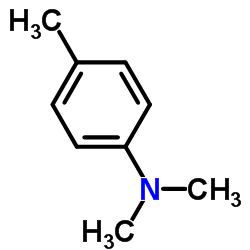N,N-二甲基对甲苯胺

N,N-二甲基对甲苯胺结构式

|
常用名 | N,N-二甲基对甲苯胺 | 英文名 | 4,N,N-Trimethylaniline |
|---|---|---|---|---|
| CAS号 | 99-97-8 | 分子量 | 135.206 | |
| 密度 | 0.9±0.1 g/cm3 | 沸点 | 211.6±9.0 °C at 760 mmHg | |
| 分子式 | C9H13N | 熔点 | -25°C | |
| MSDS | 中文版 美版 | 闪点 | 83.3±0.0 °C | |
| 符号 |


GHS06, GHS08 |
信号词 | Danger |
|
The novel semi-biodegradable interpenetrating polymer networks based on urethane-dimethacrylate and epoxy-polyester components as alternative biomaterials.
Acta Bioeng. Biomech. 17 , 13-22, (2015) This paper presents the pilot study aimed at the development of new full interpenetrating polymer networks based on urethane- dimethacrylate and biodegradable epoxy-polyester as the proposition of new biomaterials with gradually emerging porosity.The urethane... |
|
|
Novel bioactive polyester scaffolds prepared from unsaturated resins based on isosorbide and succinic acid.
Mater. Sci. Eng. C. Mater. Biol. Appl. 45 , 64-71, (2014) In this study new biodegradable materials obtained by crosslinking poly(3-allyloxy-1,2-propylene succinate) (PSAGE) with oligo(isosorbide maleate) (OMIS) and small amount of methyl methacrylate were investigated. The porous scaffolds were obtained in the pres... |
|
|
Pullulan/dextran/nHA macroporous composite beads for bone repair in a femoral condyle defect in rats.
PLoS ONE 9(10) , e110251, (2014) The repair of bone defects is of particular interest for orthopedic, oral, maxillofacial, and dental surgery. Bone loss requiring reconstruction is conventionally addressed through bone grafting. Depending on the size and the location of the defect, this meth... |
|
|
CuCl2-catalyzed one-pot formation of tetrahydroquinolines from N-methyl-N-alkylanilines and vinyl ethers in the presence of t-butylhydroperoxide.
Molecules 11(12) , 978-87, (2006) Tetrahydroquinoline skeletons can be formed by a CuCl2-catalyzed one-pot reaction of N-methyl-N-alkylanilines and vinyl ethers in the presence of t-butyl-hydroperoxide. |
|
|
Tuning emissive states in electrogenerated chemiluminescence.
J. Am. Chem. Soc. 126(32) , 10183-9, (2004) Electrogenerated chemiluminescence (ECL) arising from the reaction of radical ions has previously be shown to arise from a variety of states including excited singlets, triplets, excimers, and exciplexes. In this work we describe two systems that form emissiv... |
|
|
Effect of propionaldehyde or 2,3-butanedione additives on the mechanical properties of Bis-GMA analog-based composites.
Dent. Mater. 25(1) , 26-32, (2009) The purpose of this study was to evaluate the effect of two additives, propionaldehyde/aldehyde or 2,3-butanedione/diketone, on mechanical properties of Bis-GMA-based composites containing TEGDMA, propoxylated Bis-GMA (CH(3)Bis-GMA) or propoxylated fluorinate... |
|
|
Network structures of Bis-GMA/TEGDMA resins differ in DC, shrinkage-strain, hardness and optical properties as a function of reducing agent.
Dent. Mater. 27(5) , 497-506, (2011) To evaluate the influence of different tertiary amines on degree of conversion (DC), shrinkage-strain, shrinkage-strain rate, Knoop microhardness, and color and transmittance stabilities of experimental resins containing BisGMA/TEGDMA (3:1wt), 0.25wt% camphor... |
|
|
Toxicology and carcinogenesis studies of N,N-dimethyl-p-toluidine (CAS No. 99-97-8) in F344/N rats and B6C3F1/N mice (gavage studies).
Natl. Toxicol. Program Tech. Rep. Ser. (579) , 1-211, (2012) N,N-dimethyl-p-toluidine was nominated for toxicology and carcinogenesis studies by the National Cancer Institute based on the potential for human exposure through its use in dental materials and bone cements and the lack of toxicity and carcinogenicity data.... |
|
|
Influence of the activator in an acrylic bone cement on an array of cement properties.
J. Biomed. Mater. Res. A 81(3) , 544-53, (2007) In all but one of the acrylic bone cement brands used in cemented arthroplasties, N,N-dimethyl-4-toluidine (DMPT) serves as the activator of the polymerization reaction. However, many concerns have been raised about this activator, all related to its toxicity... |
|
|
Synthesis and characterization of cyclic acetal based degradable hydrogels.
Eur. J. Pharm. Biopharm. 68(1) , 67-73, (2008) While many synthetic, hydrolytically degradable hydrogels have been developed for biomedical applications, there are only a few examples whose polymer backbone does not form acidic products upon degradation. In order to address this concern, we proposed to de... |